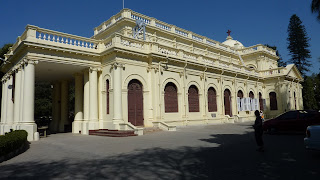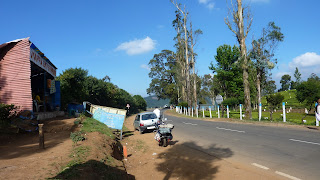Motorcycle diary
Let me start by not recommending you follow my example. I have ridden a scooter around Vancouver for about 15 years and my confidence is reflected by my aggressive riding habits. I enjoy the thrill of weaving in and out of traffic, using bicycle lanes to pass and racing at 125kph on the highway. My record for the approx 20 Kilometres from the West End in downtown Vancouver to Horseshoe Bay is 17 minutes and I only ran 3 red lights on the way!! Riding a motorcycle round India? What a thrill! I jumped at the idea and pooh-poohed Wendy’s fears. In preparation, I rented a 201cc bike in Vancouver for $150/day and took my driving test to upgrade my scooter licence to allow me to drive a motorcycle – I was failed for going too slow!
Once in Delhi, we looked around for motorcycle rental, and found a dealer willing to rent us a classic Royal Enfield 500cc “Machismo” for $11/day without checking my driving licence closely, and we were committed. Built virtually the same way since the 1930’s, this is the bike used by the Brits in WW II and is a far cry from my modern Japanese-built scooter. There were a few days delay before we could get a train ticket to Chennai (Madras) our planned starting point, and I used the intervening time to study the way Indians drive.
Typically, Indian drivers do not pay much attention to anything behind their vehicle, and aggressive drivers push their noses forward, beeping or honking hard. Once ahead, even by a few inches, it is for the vehicle behind to give way. Entering traffic takes right-of way if it is in front of you, and opposing lanes are used at will, if you can get there first. This leads to appalling snarls, with all traffic blocked until someone gives way and the fun begins again. Traffic police watch seemed to with boredom on their faces. The only evidence of their involvement was the unnerving sight of a policeman viciously pulling the hair of some poor young tuk-tuk (3-wheel auto-rickshaw) driver who had obviously been caught transgressing some rule or other. Traffic is absolutely chaotic in the smaller roads in town, and I searched for the courage needed to ride in India.
Rajeesh, who rented us the bike, agreed to take me to a quiet spot in Dehli so that I could get used to the bike before venturing into traffic, but when the time came, instead of being taken to this quiet area, I was required to follow his man through the mayhem of Karol Bargh to get there.
Panic, panic, but I could not show my fear and wimp out. Onto the bike, loaded with all our stuff, but fortunately no Wendy, and I launch into the traffic. The front wheel wobbles side-to-side at low speed and I try to turn out of the shop into the traffic and over I go onto the road, to the great amusement of all the many local motor-bike shops! I am pulling at the heavy bike to get it upright again and men rush to help. Not a good start. A moment to face the embarrassment and we are off again, weaving through cars, motorcyces, scooters, tuk-tuks, people, cows, and bicycle-rickshaws, trying avoid the pot-holes and attention of the few watching traffic police. The quiet place is much further than I would have liked, but we get there and I can at last practice.
A motorbike is not a scooter which has an automatic transmission and can be driven entirely by my right hand using the throttle and one hand brake. A motorbike needs both hands and both feet working in synchronized co-ordination. The left hand operates the clutch and horn, the left foot changes gear, the right foot the rear break and the right hand operates the throttle and front brake. In India, the horn is the most used instrument after the throttle. It is used more than the brake or clutch and gears. Since drivers typically only look ahead, it s used to warn people in front that you are behind, and going to get your nose ahead at the first opportunity possible – beep-beep, honk-honk! Operating a motorbike on a highway, with space and time to think of which hand and foot is needed to operate the bike is pretty easy. In the cities, you need to be able to operate the bike instinctley, without thinking so you can use your attention for navigating and staying alive. My 150 kilometers of ridingexperience in Vancouver was not enough, and it was a miracle that I was able to drive in Delhi, without any accident.
A half-hour practise in a disused park, then we were off to the railway station - one of the technicians delivered Wendy to the training area. I had sussed out the route earlier and knew an easy way. Rajeesh knew an easier way, and sent one of his mechanics to guide us. Needless to say his way was both longer and harder and eventually the mechanic abandoned us and waved us on in the right direction and we were on our own. We made it to the station and spent most of the rest of the day getting the bike packed and into the baggage van of our train to Chennai.
Arriving in Chennai after two nights and a day on the train, We watched to bike unloaded and got it cleared out of the station. Then unpacked, and re-fuelled (tank was drained for transit) and we launched into Chennai traffic. Fortunately it was a short easy run to our hotel.
For the next day, I had studied the route out of town carefully on the map. The way was straight-forward, and I was confident: turn left over the bridge to the seafront, then right and straight out of town. What could be simpler? It was not long before the road we were on hit a T-junction that was not on the road map and I turned right, then left again, heading for the sea?. The road started winding. Street names were very difficult to find and those we did find, were often not on the map. Roads were often diverted and by the time we had gone round a few large circles that spewed us out into other roads with multiple choices, our sense of direction was lost and lost again. Asking directions caused more confusion as the instructions given were conflicting and vague. This was before we found out that the only people to ask directions from are the tuk-tuk drivers. They know all the roads. Some two hours of circling the city in traffic and we are finally directed onto a toll road going South where we want to go.
At least we can noow confidently ride in traffic! The solution is to drive slowly at our own pace, and just ignore the beep-beeps and honk-honks . Hand on clutch and foot on break, ready for the unexpected. It is not as hard as it looks. Most Indian drivers proceed at a reasonable pace and they are not angry drivers. It is the tuk-tuks and other two-wheel riders that are always trying to nose in front of you, but they are not travelling fast and they are highly manoeuvrable. You can make your way along quite merrily, if you keep your cool.
Finally a clear stretch of road and we can move up the gears to top. The sun warms our bare arms and the country starts to unfold. The powerful Machismo comes into its own, purring happily between my legs and I start to pass all the lesser-powered bikes that had nosed in front of me in town. Pure exhilaration, we become part of all the sights, smells, tastes and feelings that are India. I feel like Toad of Toad Hall and shout “The open road, the open road!” It‘s fun - just don't end up in the ditch, like Toad! Without a windshield, 80kph feels like 160kph, so there is no incentive to go faster, which is just as well as that would be dangerous.
Clear roads come to villages with lots of people, vehicles and wicked speed-bumps that will throw a rider unlucky enough to be going too fast. Slow to a fast-walking pace, and the villages too can be easily navigated. Some villages have long sections with nothing but ruts and potholes – I’m told this is the result of a local politician siphoning off state money that was sent for the roads. Some drivers use the slow-down in villages to pass aggressively, and honk-honk their way past. One can stop at numerous stalls and get a great (but small) coffee for 23cts, or two delicious parathas (bread patties) and curry gravy for 75cts. This is the life!
Riding in India is not that hard, once you gethe hang of how the Indians drive. They are generally a lot more cautious than they appear. Many drive slowly and carefully like we do. We saw very little road rage, despit their anoying habit of nosing in front of you if you leave the smallest of gaps in front, and the persisent honk-honks to pass.
Roads are mostly not bad, but they do become narrow in places and pot-holes appear without warning on side roads. You also need to contend with dust, gravel and vehicle exhaust. On coming vehicles will use your lane to pass and you have to move over to the edge of the road, or even onto the dirt shoulder, to let them by. On coming motor bikes will also use you lane to pick up speed when joining your road from the side before crossing over to their own correct lane. But all can be managed and there is a thrill to be 70, and riding through India like a teenager!




















































